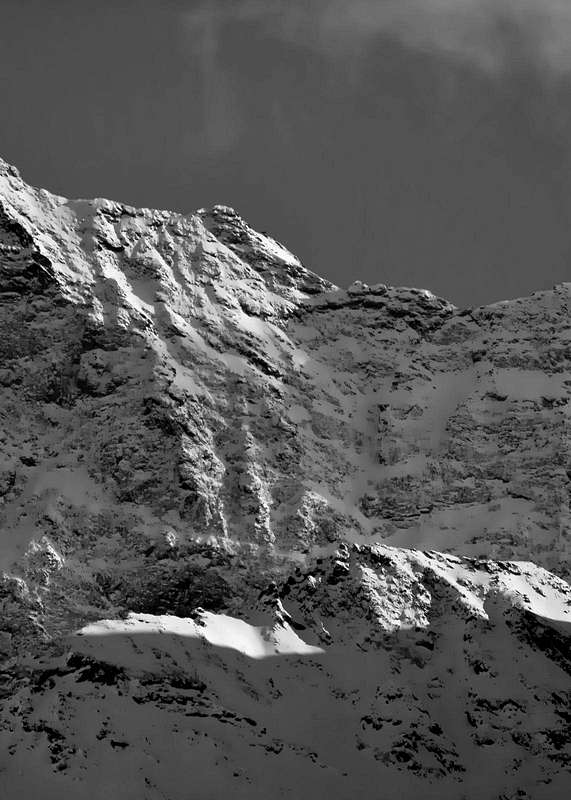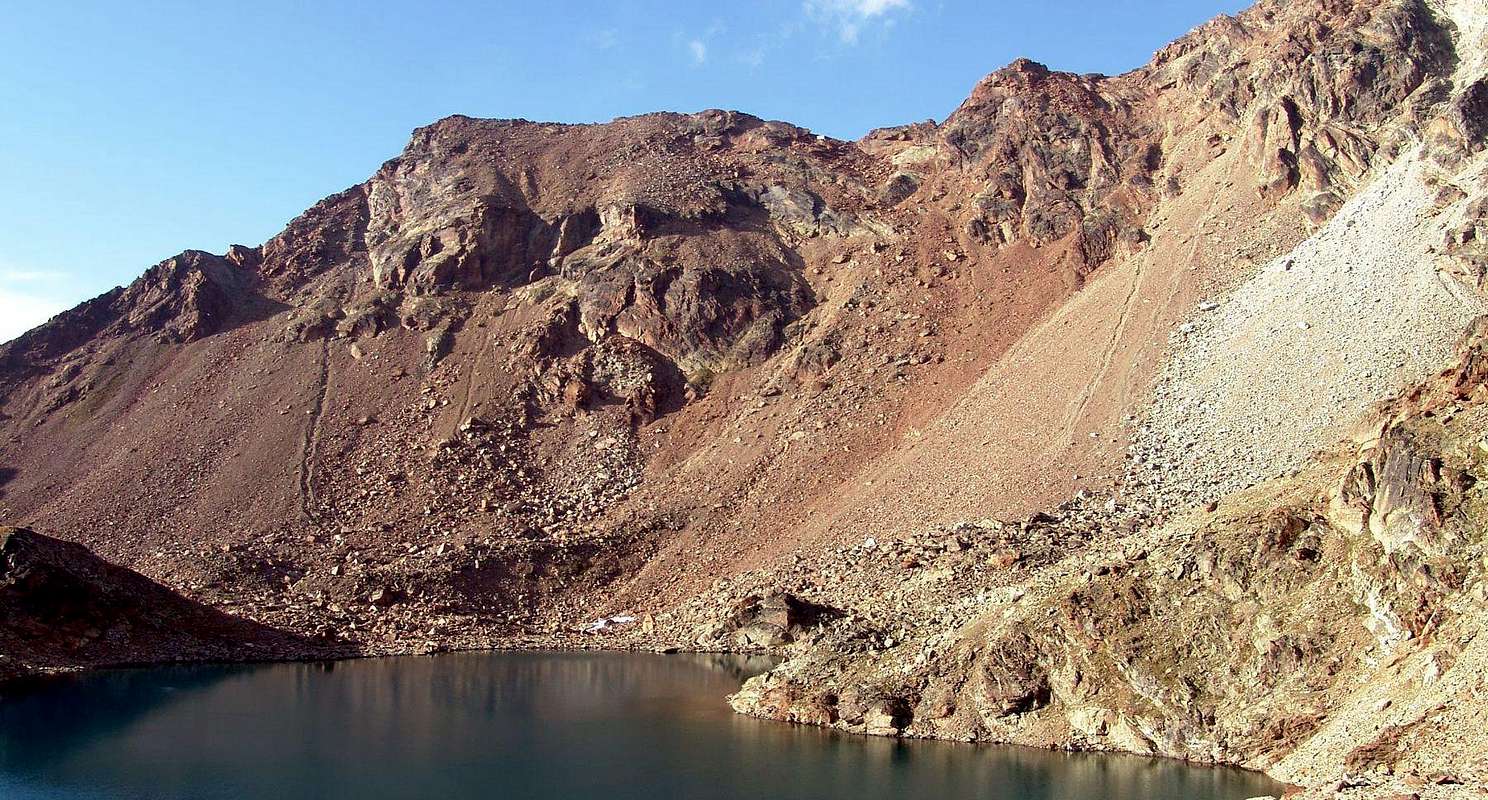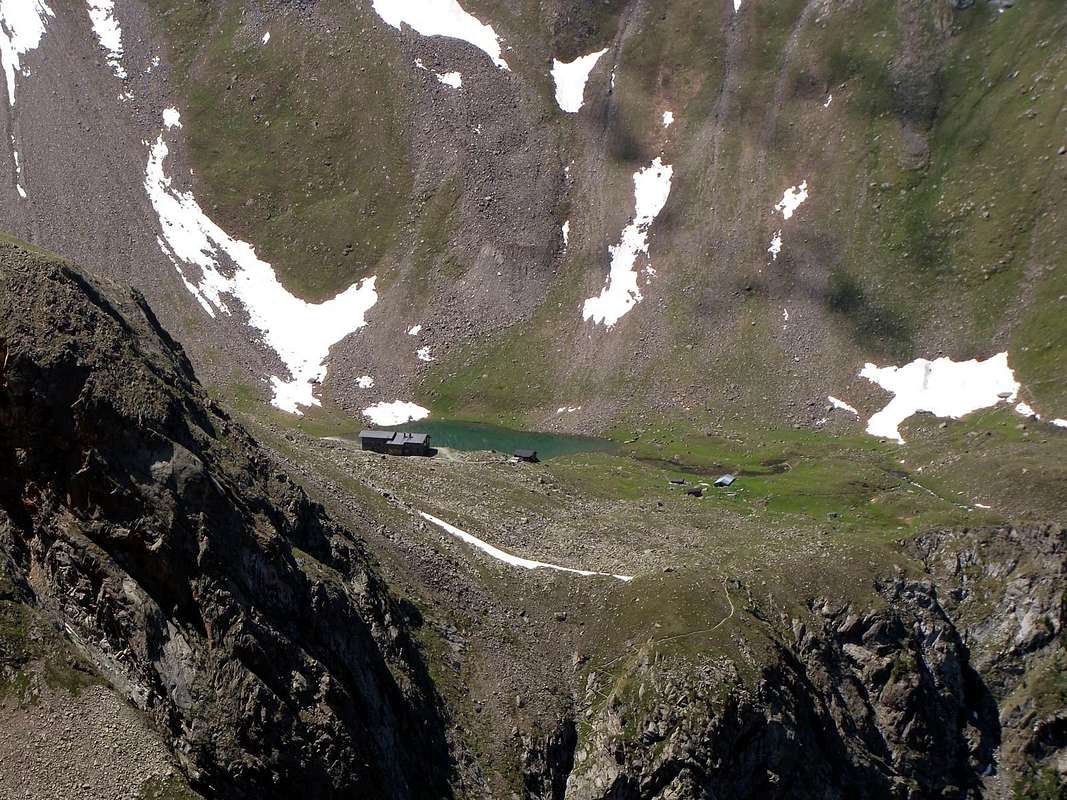-
 3232 Hits
3232 Hits
-
 85.36% Score
85.36% Score
-
 20 Votes
20 Votes
|
|
Mountain/Rock |
|---|---|
|
|
45.67902°N / 7.37920°E |
|
|
Mountaineering |
|
|
10965 ft / 3342 m |
|
|
Overview
This tiny Summit emerges on Western Ridge of Mount Emilius that, after an initial steep section, reaches the same. Beyond the ridge continues Westward reaching the Summit of Mont Ròss de Comboé (3.285m), where it splits with one branch going down towards Northwest towards Col Carrel (2.912m) and a second South-southwest in the direction of the ridge separating the Vallons of Arbolle and Comboé (Col Ròss, Punte del Lago Gelato, Col de Comboé, Trident de Arbolle). Very rarely it achieved in the past, although it recorded a first winter ascent, currently knows a good attendance as an intermediate transit point on the "Via Ferrata" at the Federigo Camp Zullo (2.907m) at the Colle Carrel. On the Northern side has a steep wall of over 450 meters above the Western Arpisson Glacier. The same has been climbed on a single occasion in 1897 in an attempt to go in the first ascent of the North Wall Monte Emilius (3.559m) having to settle for this "trick" with exit to the East of the Little Emilius to altitude of 3.420/30 meters about. It is no longer repeated, also for its dangerousness being somewhat exposed to falling stones. A Southern presents instead a much shorter slope that rises above Lake Gelato (2.956m); the same is split into two parts with a small Wall Southwest still unclimbed, and, after a Southern Edge climbed on a single occasion in 1968, a slope of scree and easy downhill debris in 1911. But the first absolute ascent should be made by the Abbé Marie Joseph Henry with Charvensod Mountain Guide Grégoire Comé September 17th, 1902 and September 20th following repeated by Felice Mondini and Enrico Questa, departing directly from Aosta Town and unaware of the previous ascent by Henry-Comé, carried out a few days before starting by Charvensod Hamlet. A double exploit in a very short time followed by a long silence until the '40s, with the first winter of the Trieste Nerino Gobbo winter of 1940/41 and the crossing downhill by the Mountain Bearer Giulio Adolfo Ourla said "Dulo" with his wife Aurora Wuillerminaz 20th July 1941. So another long silence until the 60's/70.

First Ascents
- First on the Summit: Abbot Marie Joseph Henry with Charvensod Mountain Guide Grégoire Comé, (Sep 17th 1902); second ascent by Felice Mondini and Enrico Questa (C.A.I. Ligurian Section), (Sep 20th, 1902).
- In winter: Nerino Gobbo, (1940/41).
- North Wall: Ercole Daniele and Giovan Battista Devalle (C.A.I. Turin) with Valtournanche Mountain Guides Louis Bich and Anselme Pession, (Aug 30th, 1897), in ascent from Arpisson Alp.
- Southern Slope (Normal Route): Giovan Battista Bozzino and Carlotta "Tina" Bozzino, (Sep 12th, 1911), in descent.
- South Edge: Osvaldo Cardellina, lone, (Oct 13th 1968), from Lago Gelato after the ascent and descent on Mont Emilius.
Getting There
BY CAR:
- From TORINO, MILANO, etc: Motorway A5. Exit at IVREA or Quincinetto (PIEDMONT).
- From IVREA Town: before in West (Southern side) to Pont Saint Martin, Verrès, Saint Vincent, Chatillon, Nus, Aosta East (A5 exit).
- From FRANCE: through the Mont Blanc Tunnel to Entrèves/Courmayeur. By Little Saint Bernard Pass, closed since November until half May.
- From Aosta City before to the South, crossing Dora Baltea, towards Le Pont Suaz and Charvensod Commune, after in East and Southwest towards Peroulaz, Les Fleurs, Rosselin, Grande Cerise Villages until Pila Resort.
BY PLANE:
- Aeroporto "Corrado Gex" Saint Christophe (Aosta).
Approach with relative Route
From Pila through Arbolle Valley: from Pila Resort (famous and crowded ski resort just above Aosta - Cableway or Bus service), to the Chamolé Lake (2.311m), using chairlift or on foot, and on to the homonymous pass (2.641m), through it go down to the new (built in 1998) and comfortable Arbolle Refuge (2.510m) with a large mule track and path n° 16/TVC above the Arbolle Lake with it effluent. After continue towards East and South, with the same route n° 14 for the Monte Emilius (3.559m), till the Lago Gelato (2.956m). From this point back to the North, no path and nor traces, towards the overlying stony that progressively increases in steepness until it reaches the watershed immediately to the East of the Little Emilius. At first go directly to the reddish morain leaving on the right (East) that gray which climbs towards Monte Emilius; then bend with a curved path to the left (Northwest) reaching the West Ridge or current (since 2004) Via Ferrata. For the easy East Crest soon to Peak (EE A/ F/F+; 3h'30/4h'00 from Pila Resort; 2h'00/2h'15 from Arbolle Shelter; 1h'00/1h'15 by Lago Gelato).
Difficulty
This route can be considered EE/F for the Southern Slope and EEA/F+ for the small Eastern Crest.Equipment
For Hiking, better with rope.
Huts
Alpe Arbolle Hut (2.507m), Difficulty: E (Hikers).
Camping
Remember that free camping is forbidden (except for emergency reasons, over 2.500m, from darkness until dawn).Mountain Condition
- Meteo: you can find all the needed informations at the official site of the Valle d'Aosta Region:
- Valle d'Aosta Meteo
Webcam
- WEBCAM on Aosta Valley:
- Webcam
Books and Maps
BOOKS:- "Guida del Monte Emilius", di Osvaldo Cardellina Editore in collaborazione con il Club Alpino Italiano Sezione di Aosta, Dicembre 1978.
- "Guida dei Monti d'Italia – Emilius Rosa dei Banchi Parco del Mont Avic" di Giulio Berutto e Lino Fornelli - Club Alpino Italiano/Touring Club Italiano, Marzo 2005.
- "Guida delle Alpi Occidentali" di Giovanni Bobba e Luigi Vaccarone C.A.I. Sezione di Torino Volume II (parte II), 25 Maggio 1896.
- "Diari Alpinistici" di Osvaldo Cardellina e Indice Generale accompagnato da Schedario Relazioni Ascensioni 1964-2019 (inediti).
MAPS:
- Kompass "Gran Paradiso Valle d'Aosta Sentieri e Rifugi" Carta turistica 1:50.000.
- L'Escursionista "Conca di Aosta-Pila-Monte Emilius" Carta dei sentieri (n° 4) 1:25.000.
- Hapax "Les Sentiers Comunità Montana Monte Emilius", Luglio 2000 1:25.000.
- Enrico Editore Ivrea-Aosta "Gruppo del Gran Paradiso" 1:50.000.
- I.G.C. Istituto Geografico Centrale, Torino "Carta delle Passeggiate ed Escursioni in V.D.A. Conca di Pila-Gressan, 1:20.000.
Important Information
- REGIONE AUTONOMA VALLE D'AOSTA the official site.
- FONDAZIONE MONTAGNA SICURA Villa Cameron, località Villard de la Palud n° 1 Courmayeur (AO) Tel: 39 0165 897602 - Fax: 39 0165 897647.
- A.I.NE.VA. (Associazione Interregionale Neve e Valanghe).
Useful numbers
- Protezione Civile Valdostana località Aeroporto n° 7/A Saint Christophe (Ao) Tel. 0165-238222.
- Bollettino Valanghe Tel. 0165-776300.
- Bollettino Meteo Tel. 0165-44113.
- Unità Operativa di Soccorso Sanitario Tel. 118.
Acknowledgements
The fundamental support given by my friend "Osva".






